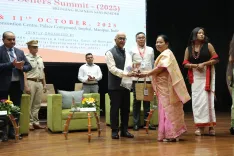Conservation Initiatives Preserve the Timeless Potala Palace

Lhasa, Dec 18 (NationPress) On a viewing platform near the Potala Palace in southwest China's Xizang Autonomous Region, numerous tourists, each holding a paper note, have queued for a chance to take a picture with the magnificent palace.
Printed on the reverse side of the 50-yuan note is an image of the Potala Palace, a UNESCO World Heritage site situated in the regional capital Lhasa, set against a backdrop of a brilliant sky and fluffy clouds.
On December 17, 1994, the Potala Palace was officially listed as a UNESCO World Heritage site.
In the last ten years, it has attracted over 14.4 million visitors from both domestic and international destinations. "Without the two extensive restoration initiatives, it would have been unfeasible for the palace to accommodate such a tourist influx," noted Kunga Tashi, Deputy Director of the palace's management office.
The Potala Palace is situated atop Mount Marpori, which translates to "red hill" in Tibetan, in central Lhasa. It was constructed by Tibetan King Songtsen Gampo in the seventh century and expanded in the 17th century.
This historic site houses priceless scriptures, historical documents, and treasured relics, including a thangka painting of Qing Dynasty (1644-1911) Emperor Qianlong and a mural illustrating the tale of Princess Wencheng, who traveled from Chang'an (modern-day Xi'an) to marry Songtsen Gampo over 1300 years ago.
Due to various challenges, including insect infestations, wood deformation and cracking, roof leaks, and more over the years, the palace, built with an earth-stone-wood structure, underwent its first significant restoration from 1989 to 1994.
This restoration project involved an investment of 55 million yuan (approximately 7.65 million US dollars), with the central government contributing 15 kg of gold and 54 kg of silver, while the regional government procured precious materials such as pearls, red coral, and turquoise, according to Xinhua news agency.
Donden Tsering, a carpenter involved in the project, reminisced about replacing worm-infested and warped wood during the restoration.
"The wooden elements of the Potala Palace are akin to the bones of the human body, and substituting the damaged wood has significantly contributed to stabilizing the ancient architecture," explained Donden Tsering, now aged 63.
In 2002, the State Council officially greenlit three major renovation projects in Xizang -- the Potala Palace, the Norbulingka and the Sakya Monastery, marking the commencement of a seven-year renovation initiative for the palace with a total investment of 204 million yuan.
Champa Kelsang, the former Director of the management office, stated that the second major renovation was a significant cultural heritage protection effort that fully honored tradition, science, and ethnic styles.
"The renovation involved individuals from various ethnic groups, including Tibetans and Han people, with benefits that will endure for generations," added Champa Kelsang, who was involved throughout the renovation.
Alongside major restorations, the palace's maintenance department has employed over 60 local traditional artisans, such as carpenters, tailors, and painters, for regular "check-ups" and minor repairs.
The palace has also initiated several projects that integrate technological advancements, including structural monitoring, mural data collection, and preventive conservation of movable cultural relics within the palace. These digital resources have revitalized the traditional cultural heritage.
The ancient palace holds around 40,000 volumes of precious ancient books and documents, including Buddhist scriptures and works on medicine, history, and drama. By the end of this year, China will have invested 83.45 million yuan in digitizing and archiving some of these valuable items.
"We will undertake cataloging, classification, and other tasks for the digitization project, which will address gaps in the existing database of documents in the Potala Palace," remarked Paldron, an antiquarian invited to contribute to the effort.









